40+ Thanksgiving Centerpieces
Thanksgiving is a time for gathering, gratitude, and creating lasting memories. Centerpieces play a crucial role in setting the tone for your holiday meal, adding warmth and charm to your dining table. By selecting the right centerpiece, you can enhance the overall aesthetic of your celebration, making it inviting for your guests.
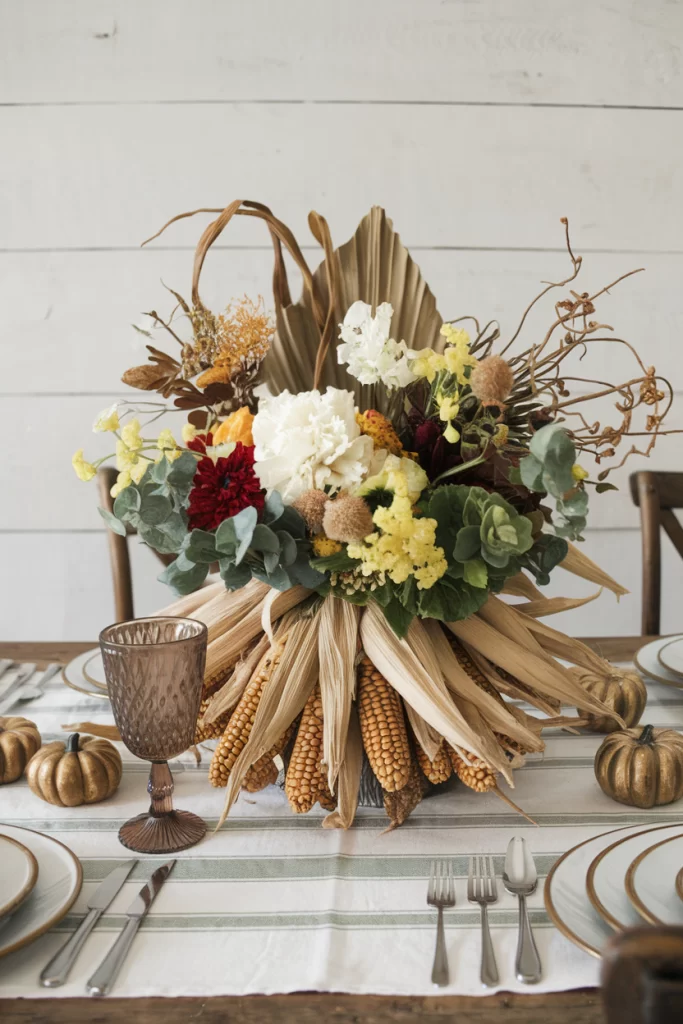
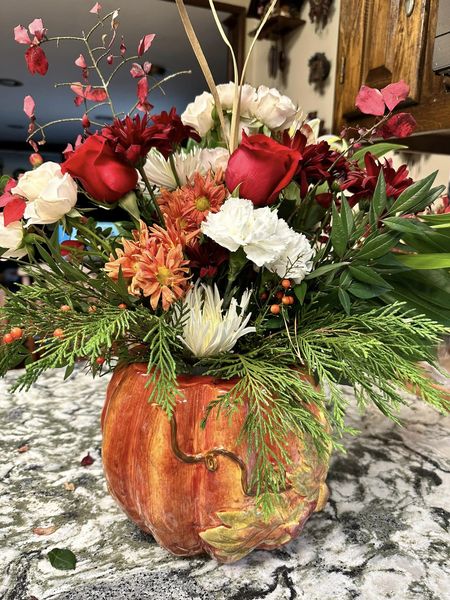
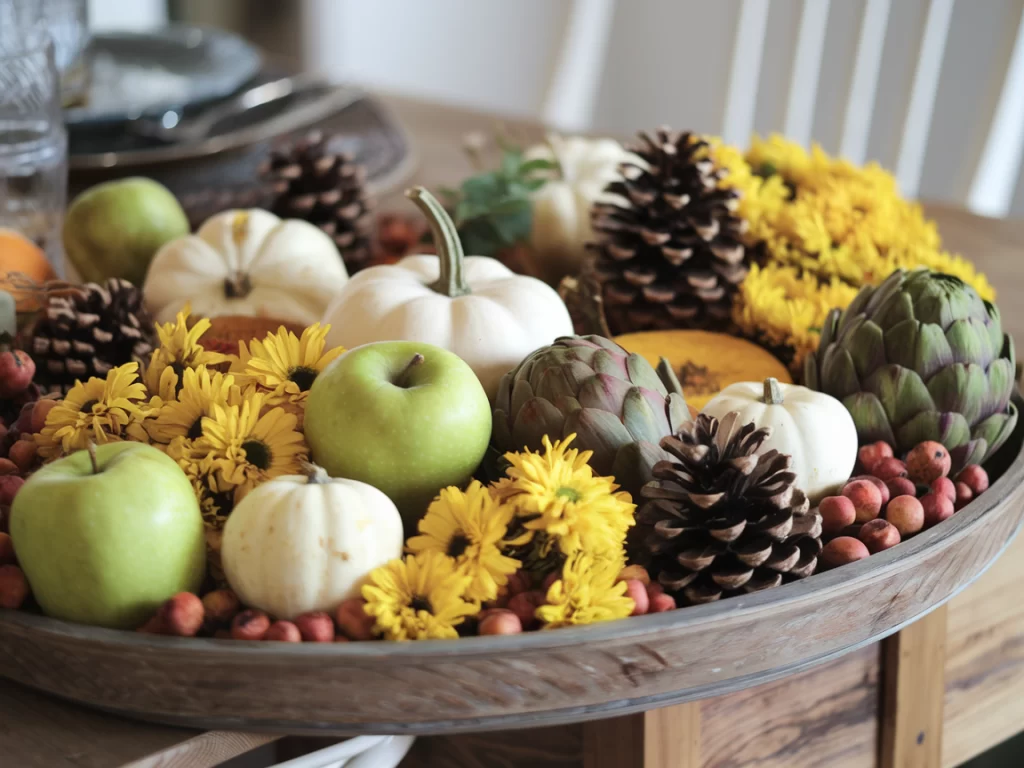

You might consider incorporating natural elements like pumpkins, gourds, and autumn leaves for a seasonal touch. Alternatively, elegant arrangements featuring flowers in warm tones can add sophistication to your dining experience. The options are endless, but the key is to choose something that resonates with your style and the spirit of Thanksgiving.
As you plan your celebration, remember that a well-thought-out centerpiece can spark conversation and bring a personal touch to your gathering. Whether you prefer a simple arrangement or an elaborate display, your choice will contribute significantly to the ambience of your Thanksgiving feast.
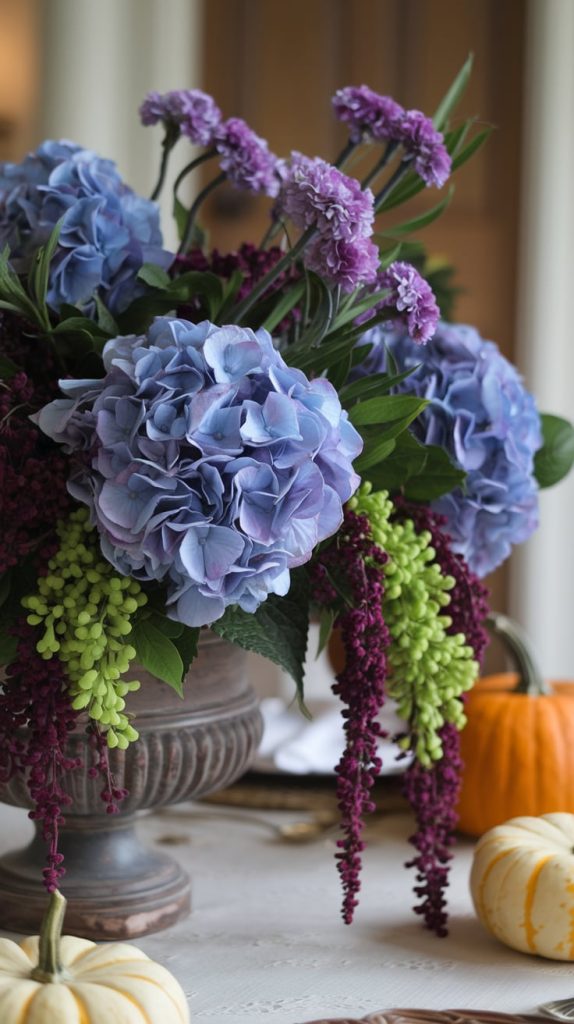
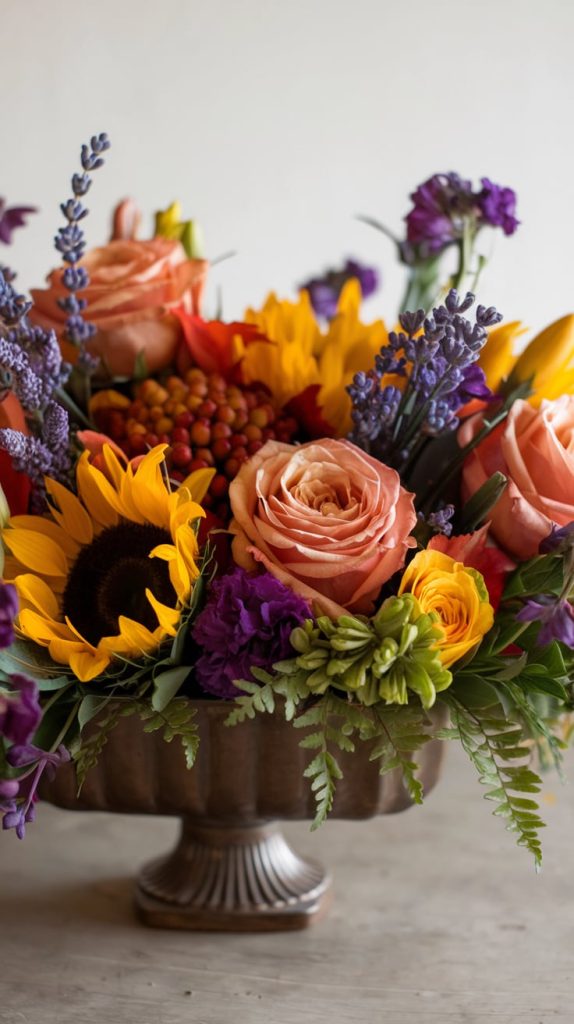
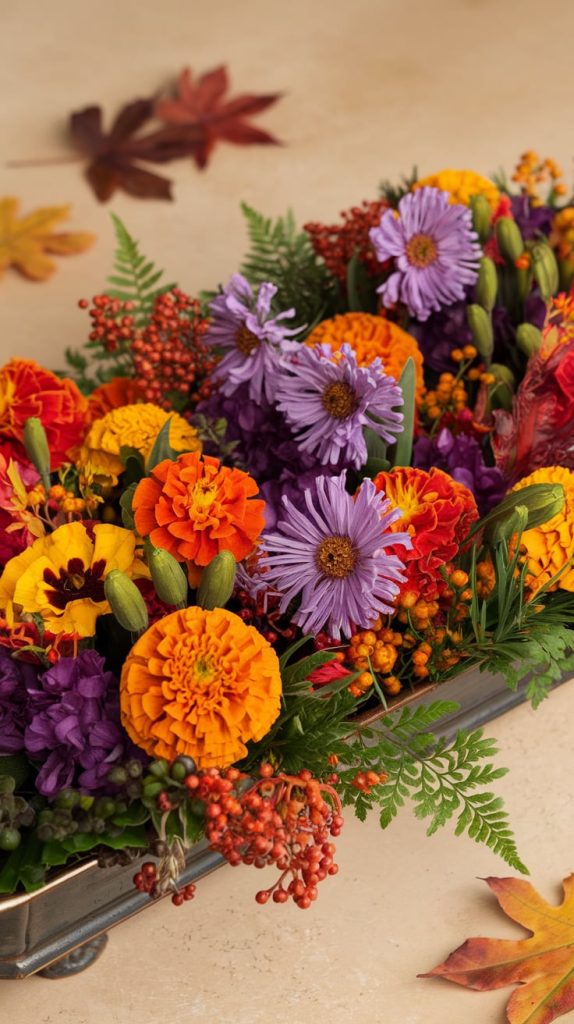
History and Significance of Thanksgiving Centerpieces

Thanksgiving centerpieces enhance the dining experience and reflect the holiday’s rich traditions. Understanding their roots and how tablescapes have evolved adds depth to your appreciation of these decorative elements.
Roots of the Tradition
The origins of Thanksgiving centerpieces trace back to the 1621 harvest feast shared by Pilgrims and Native Americans. Early tables lacked elaborate decorations; they focused on food as the centerpiece. Simple arrangements of seasonal produce, such as gourds and corn, were used to symbolize abundance.
As Thanksgiving grew in popularity, so did the tradition of decorating tables. Centerpieces began to diversify, incorporating flowers and foliage to celebrate the harvest. Materials like wheat stalks and autumn leaves reflected the season, emphasizing gratitude and togetherness.
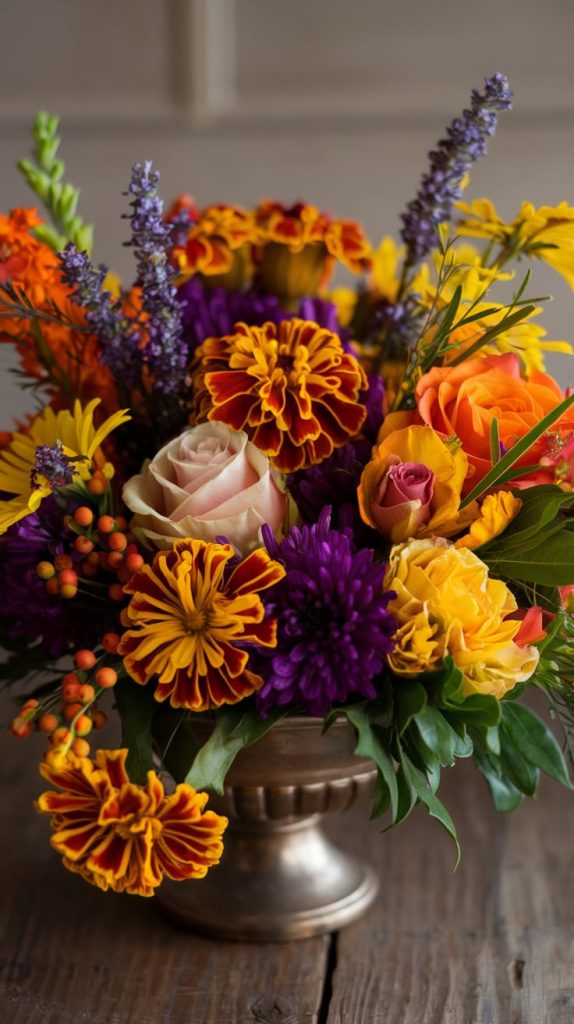
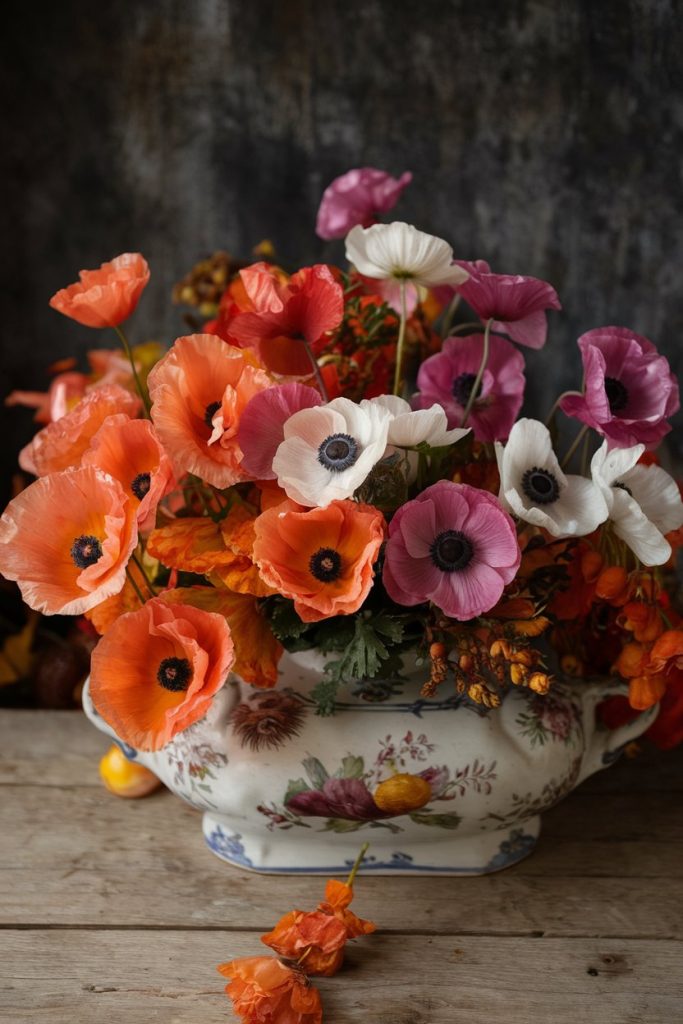
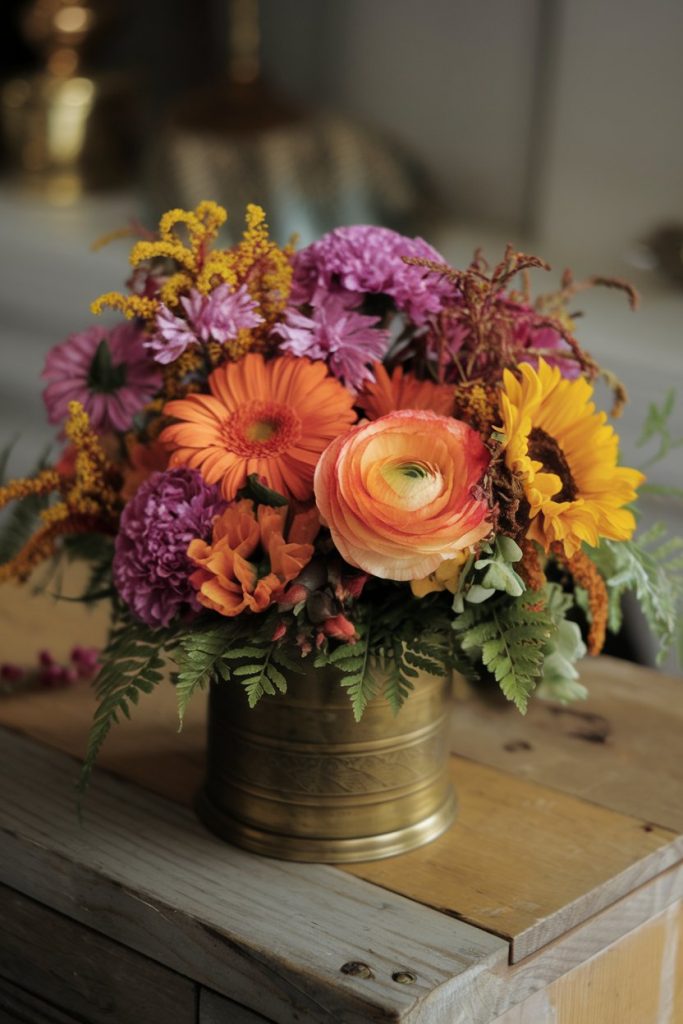
Evolution of Tablescapes
By the 19th century, Thanksgiving tablescapes became more refined. Homeowners used their creativity to create impressive displays that showcased their hospitality. Elaborate centerpieces featured fruits, nuts, and even baked goods shaped into decorative forms.
Modern Thanksgiving centerpieces continue the tradition, mixing classic elements with contemporary designs. You might choose a rustic pumpkin arrangement or a minimalist floral display, reflecting personal style. Today, centerpieces also carry themes, supporting the overall aesthetic of your gathering.
Centerpieces now serve to spark conversation, making the table an inviting space for family and friends to gather. They embody the spirit of Thanksgiving, marrying visual beauty with the warmth of shared meals.
Start with a Container

The container you select sets the tone for your Thanksgiving centerpiece. Consider using unique pieces such as antique bowls, woven baskets, or elegant serving trays. These items not only serve a functional purpose but also add character to your arrangement.
A well-chosen container reflects your personal style. For a rustic look, a weathered wooden box works beautifully. For a modern touch, try a sleek metal or glass vase. Lanterns can provide a charming focal point and introduce ambient lighting to your table setup.
When selecting your container, think about scale and proportion. A larger container can anchor your centerpiece, while smaller vessels can create a sense of intimacy. Mix and match different materials for added visual interest.
Consider the color palette of your Thanksgiving table. Choosing a neutral or complementary container can make your floral and decorative elements pop. Whether you opt for vibrant colors or subdued tones, the container plays a crucial role in bringing your vision to life.
Personalizing your centerpiece with a container you’ve collected adds a narrative element to your table. Guests will appreciate the thought and care that went into your presentation. Embrace creativity by using unexpected items to make your centerpiece stand out this holiday season.
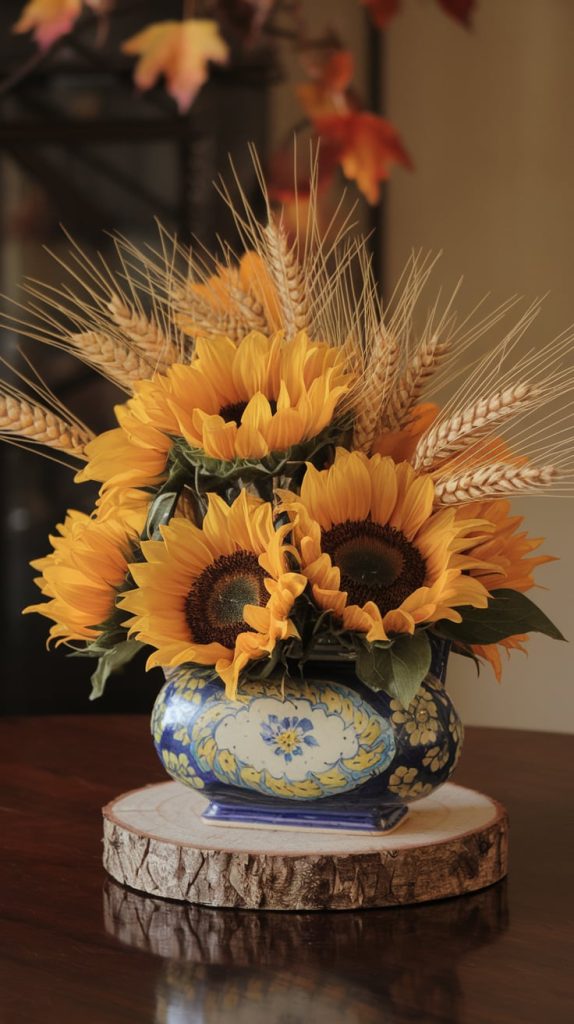
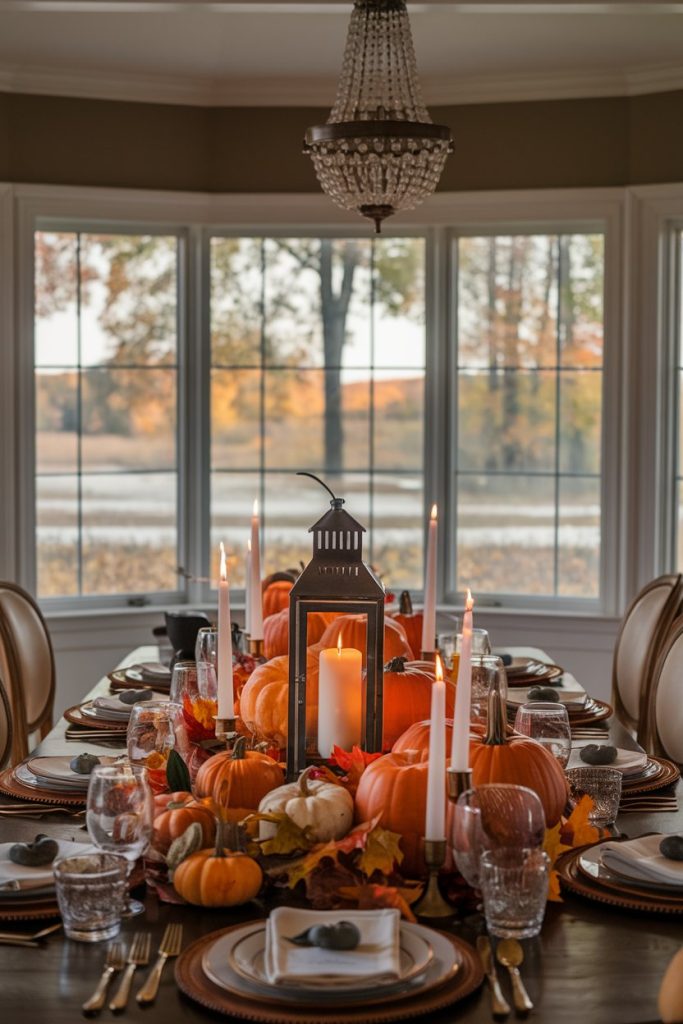
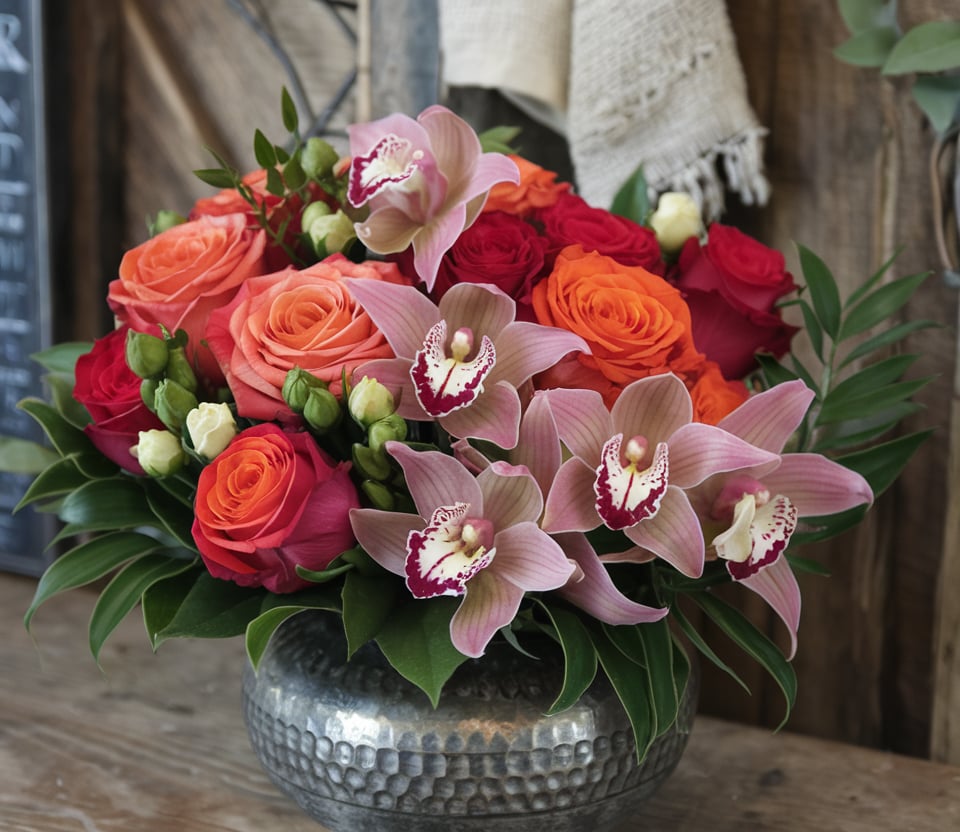
Designing Your Thanksgiving Table

Creating a Thanksgiving table involves careful consideration of theme, color, texture, and setting. When you balance these elements, you set the stage for a welcoming and festive atmosphere.
Choosing a Theme
Selecting a theme for your Thanksgiving table can guide your choices for decor and arrangements. You might opt for traditional autumn motifs, such as pumpkins, leaves, and earthy tones. Alternatively, consider a modern twist with minimalist designs and monochromatic colors.
Identify a color palette that resonates with your theme, using it for table linens, dishes, and centerpieces. For a cohesive look, the centerpiece should reflect this theme, drawing the eye without overwhelming the table. Elements like candles, seasonal flowers, or unique dinnerware can enhance the overall presentation.
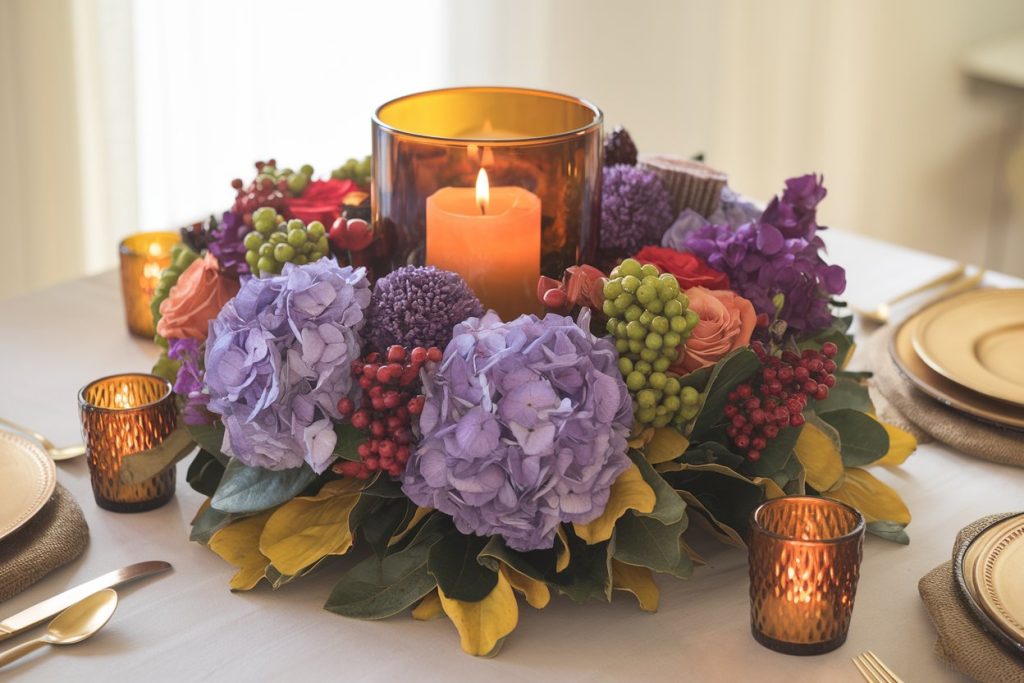
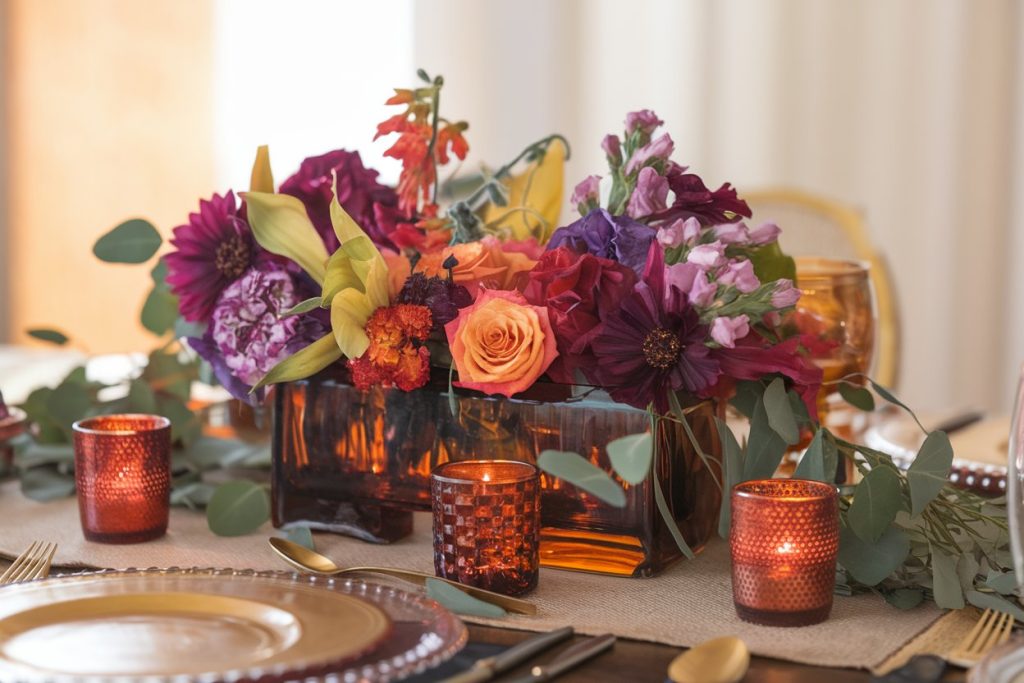
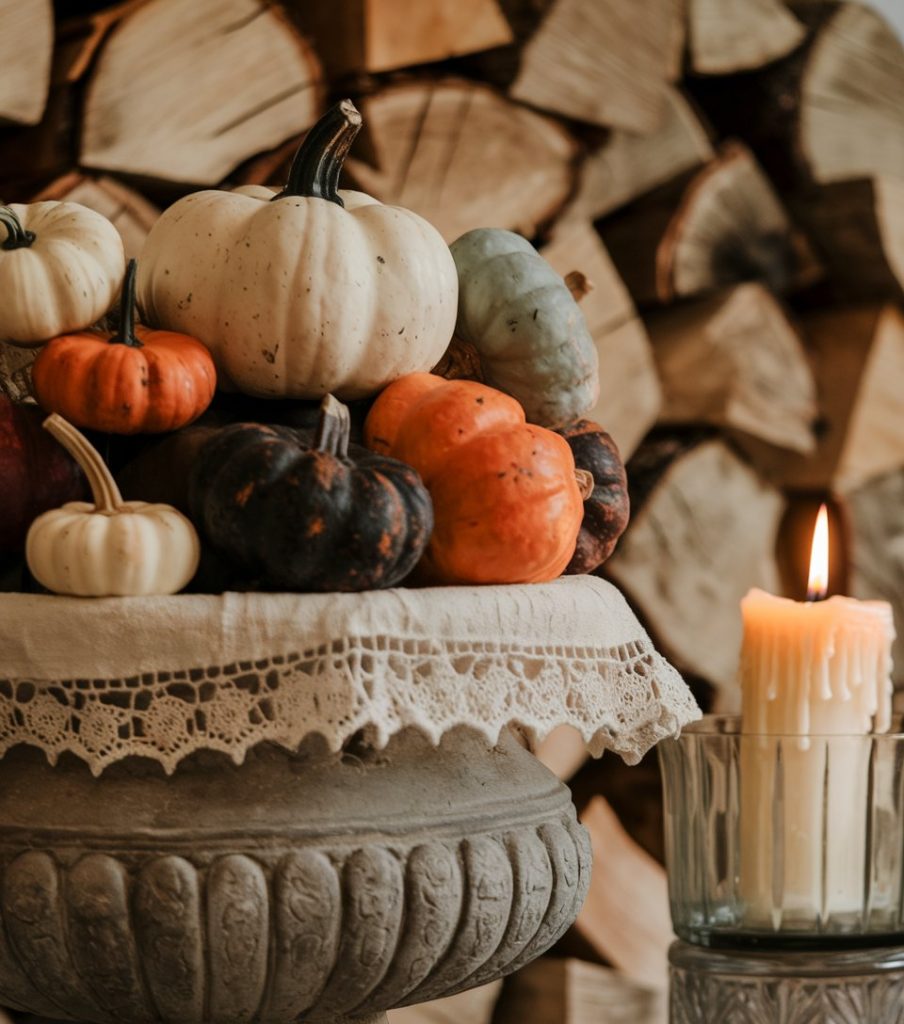
Balancing Color and Texture
Incorporating a mix of colors and textures elevates your Thanksgiving table arrangements. Choose colors that harmonize with your theme but add pops of contrasting hues for interest. For example, warm oranges and deep reds can be complemented by metallic accents for a sophisticated touch.
Texture is equally important; blend smooth plates with woven table runners or rustic wooden accents. Mixing materials, like glass, ceramic, and natural fibers, adds depth to your display. Creating layers with different heights, such as varied candle sizes or stacked dishes, enhances the visual appeal.
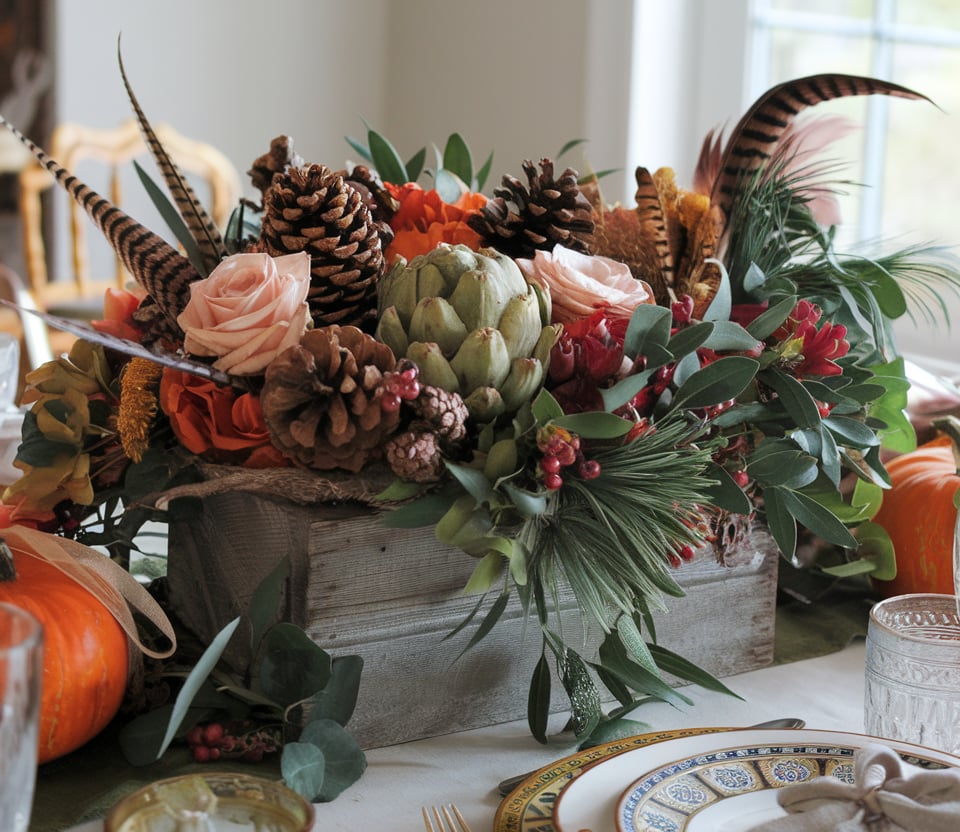
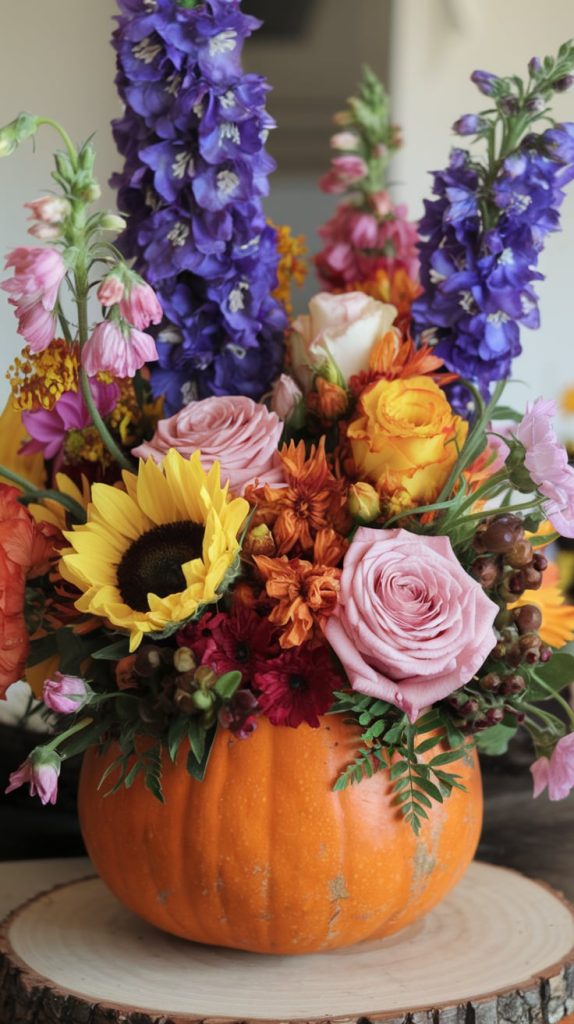
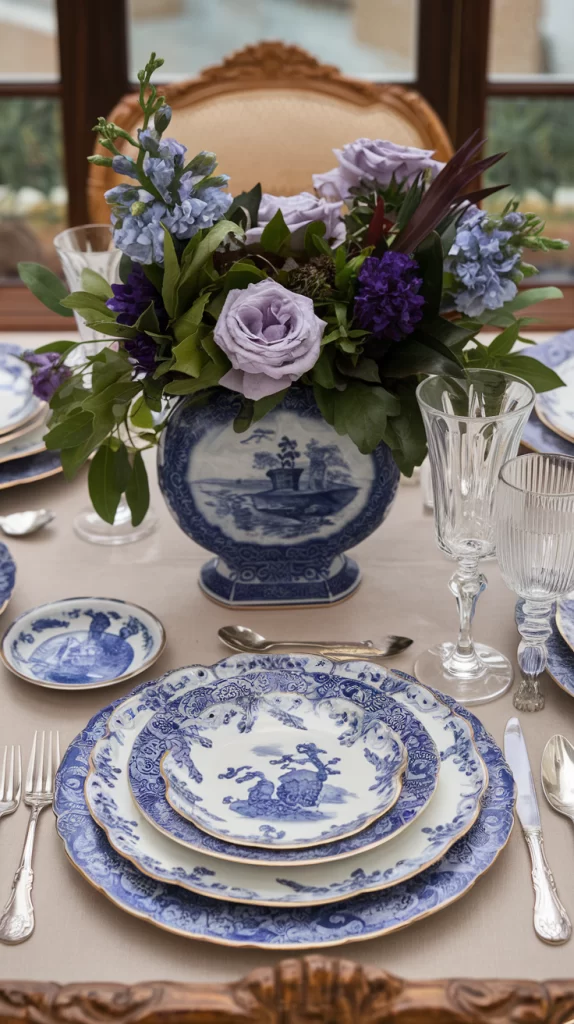
Table Setting Tips
Creating simple yet elegant Thanksgiving table settings can enhance the dining experience. Start with a clean, attractive tablecloth or runner that aligns with your theme. Use matching or complementary dishes that fit your selected color palette.
Arrange utensils thoughtfully, ensuring each setting includes necessary items, such as forks, knives, and spoons, placed in the correct order. Napkins can be folded creatively or placed in decorative holders for added flair.
Consider incorporating personal touches like place cards to guide guests to their seats. These elements make the setting feel intentional and welcoming, reinforcing the spirit of gratitude that defines Thanksgiving.
DIY Centerpiece Ideas
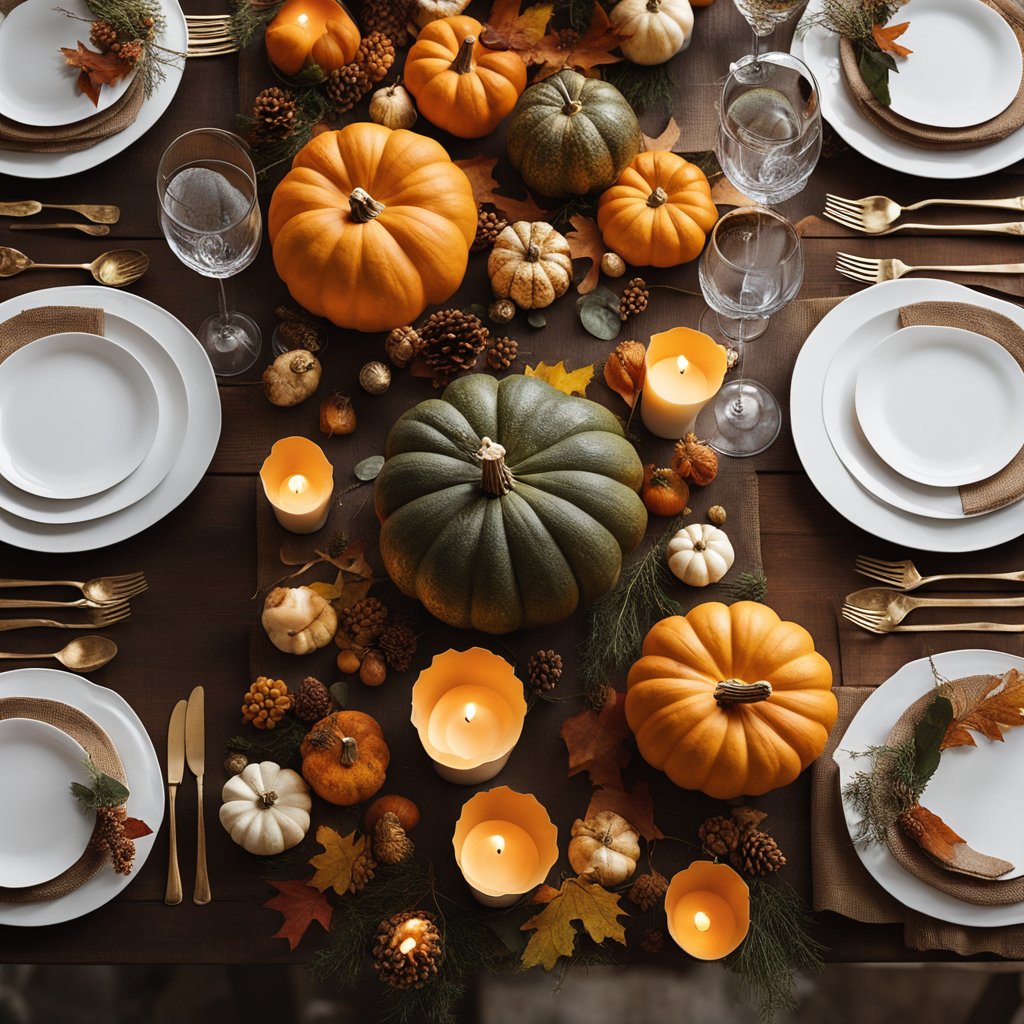
Creating a DIY centerpiece can add a personal touch to your Thanksgiving table. Here are some specific ideas focusing on seasonal elements, floral designs, and quick solutions.
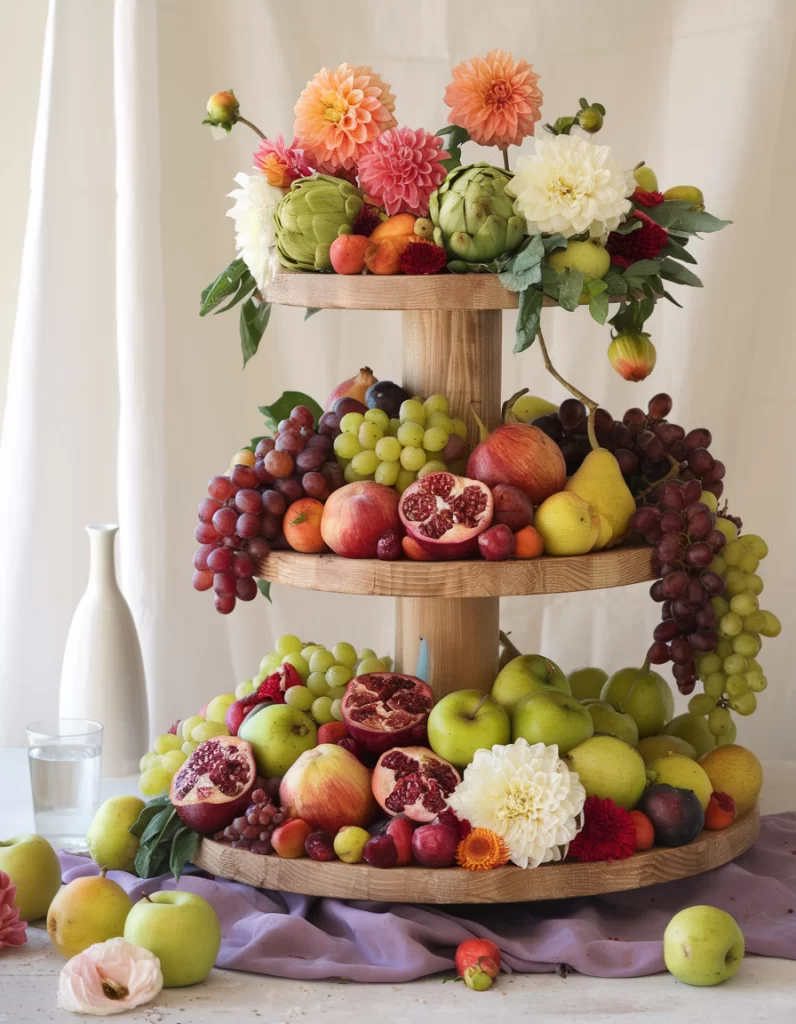
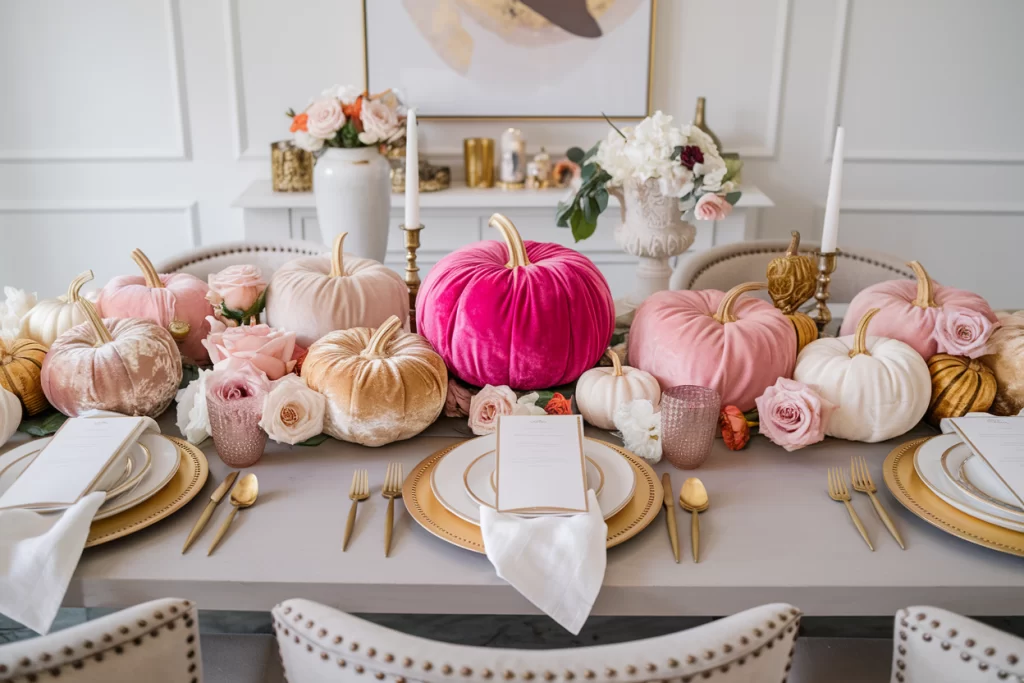
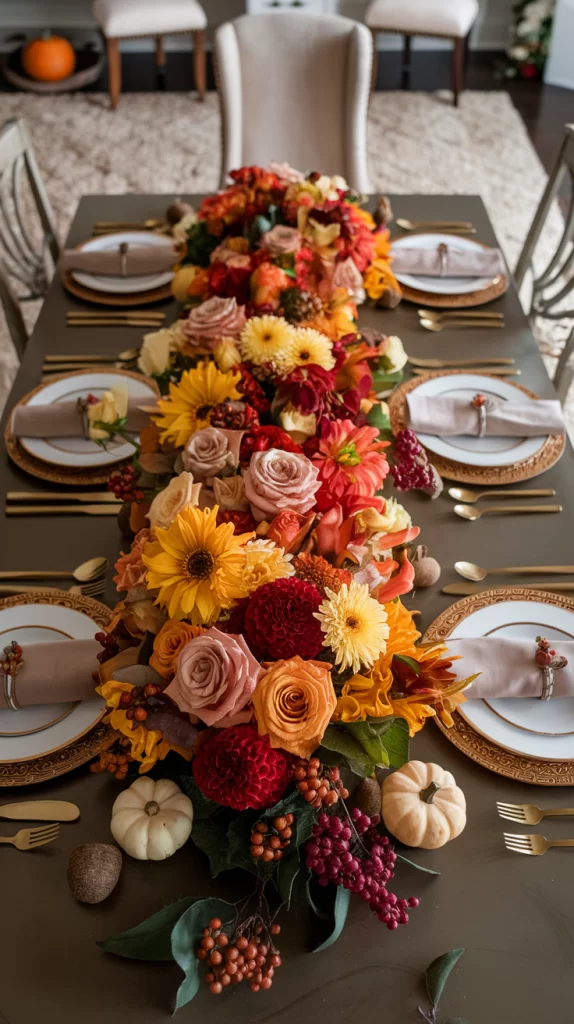
Pumpkin and Fall Elements
Incorporate pumpkins into your centerpiece for a festive touch. Choose a variety of sizes and colors, like mini white or orange pumpkins, to create visual interest. Arrange them in clusters along your table.
Consider surrounding the pumpkins with fall foliage, such as vibrant leaves, acorns, or pinecones. You can stick to a color palette using earthy tones for a cohesive look. Using a shallow bowl or tray can help contain the arrangement, making it easier to move if needed.
For a unique twist, carve out small pumpkins to use as vases. Place a simple flower or fern inside for a charming and seasonal effect. This idea highlights the beauty of fall while being easy to execute.
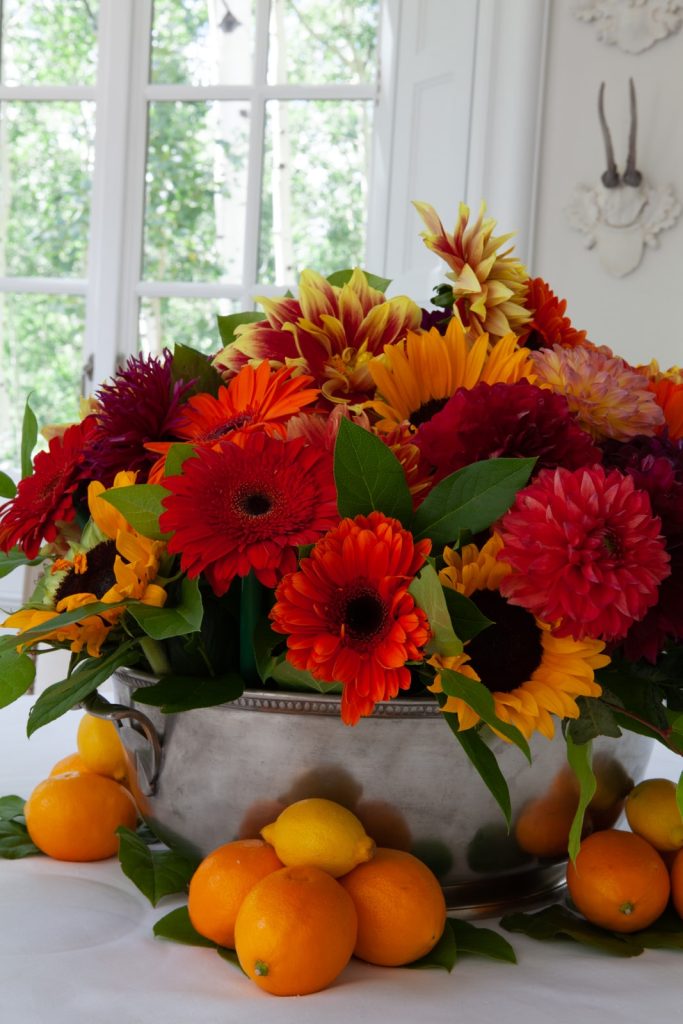
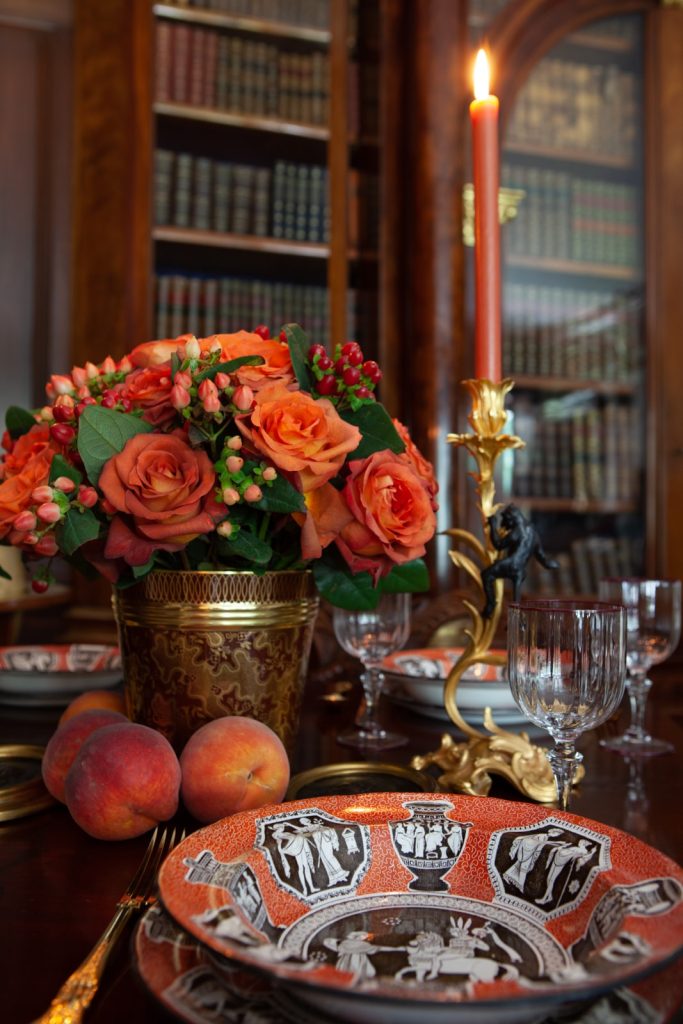
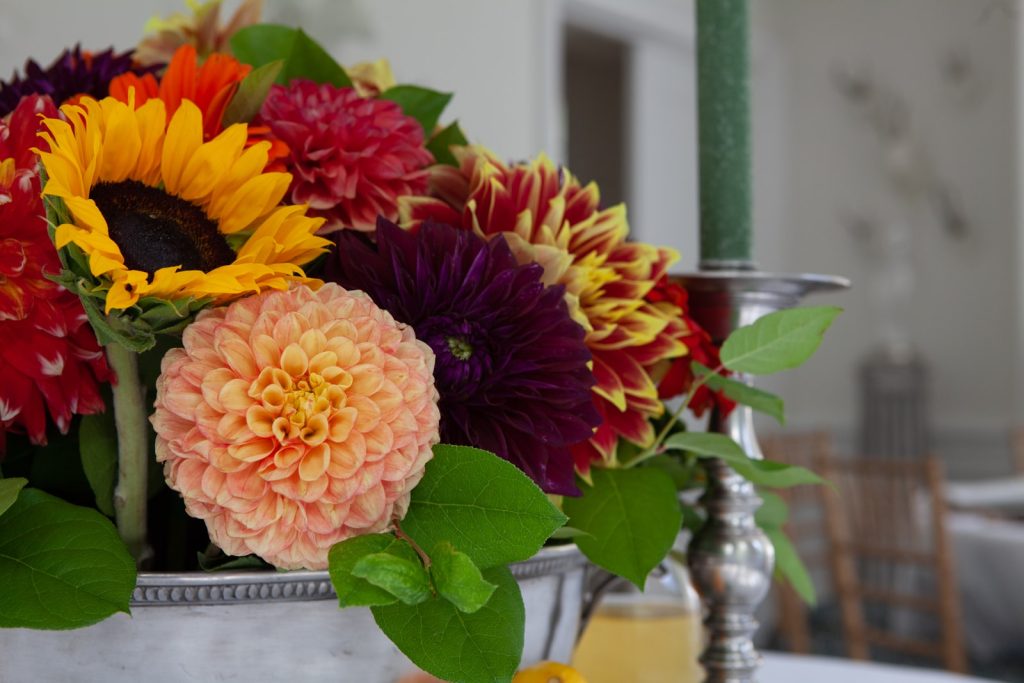
Floral Arrangements
Floral arrangements can elevate your Thanksgiving table. Use seasonal flowers like chrysanthemums, dahlias, or sunflowers. These blooms are not only colorful but also readily available in the fall.
To create your arrangement, opt for a low centerpiece to keep sight lines clear. Choose a wide, shallow container, and place floral foam inside to hold your stems.
Mix in greenery, such as eucalyptus or ferns, to add texture. You can also incorporate elements like berries or small branches to enhance the fall theme. Consider using a mix of heights in flowers to create depth and dimension.
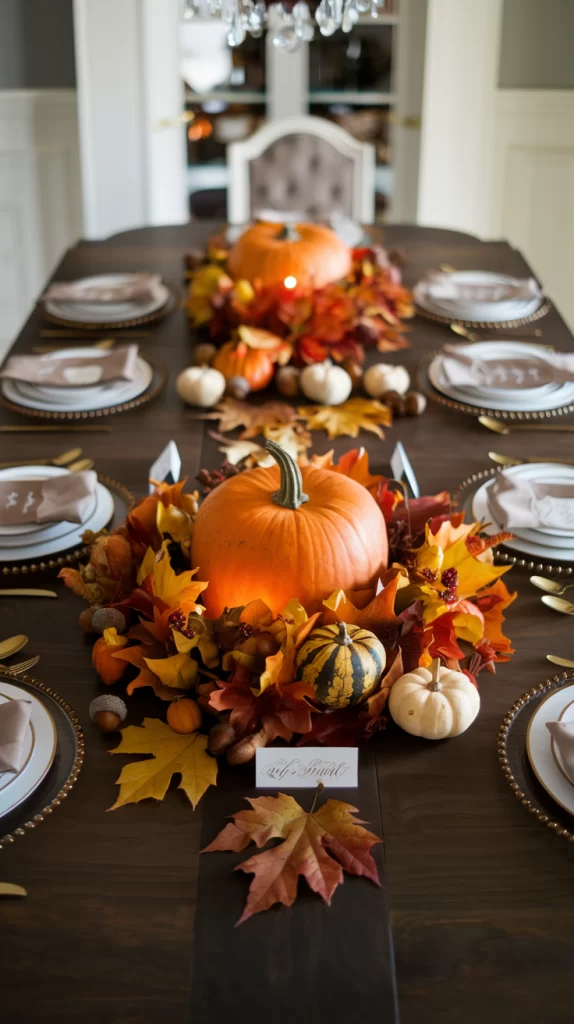
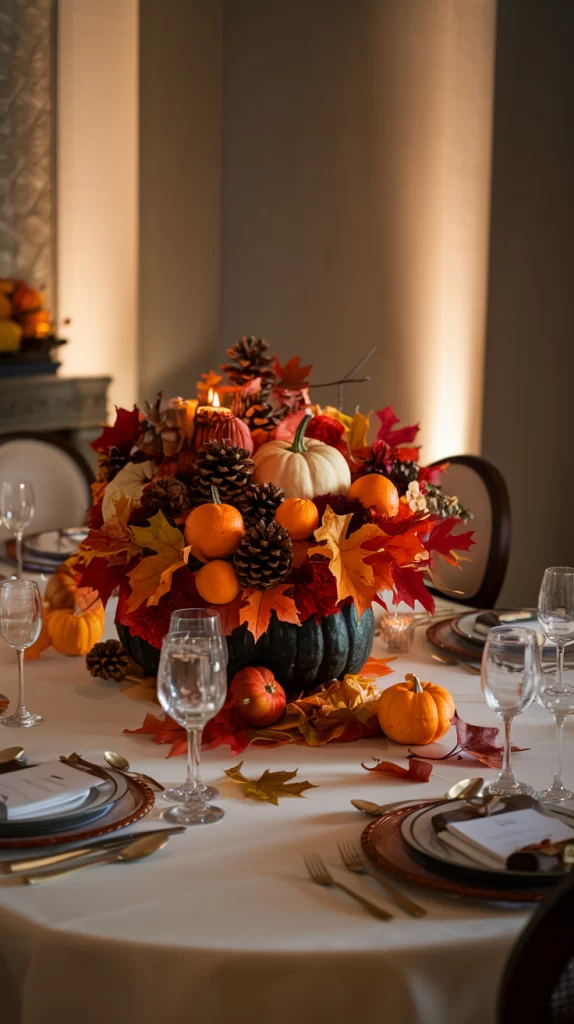
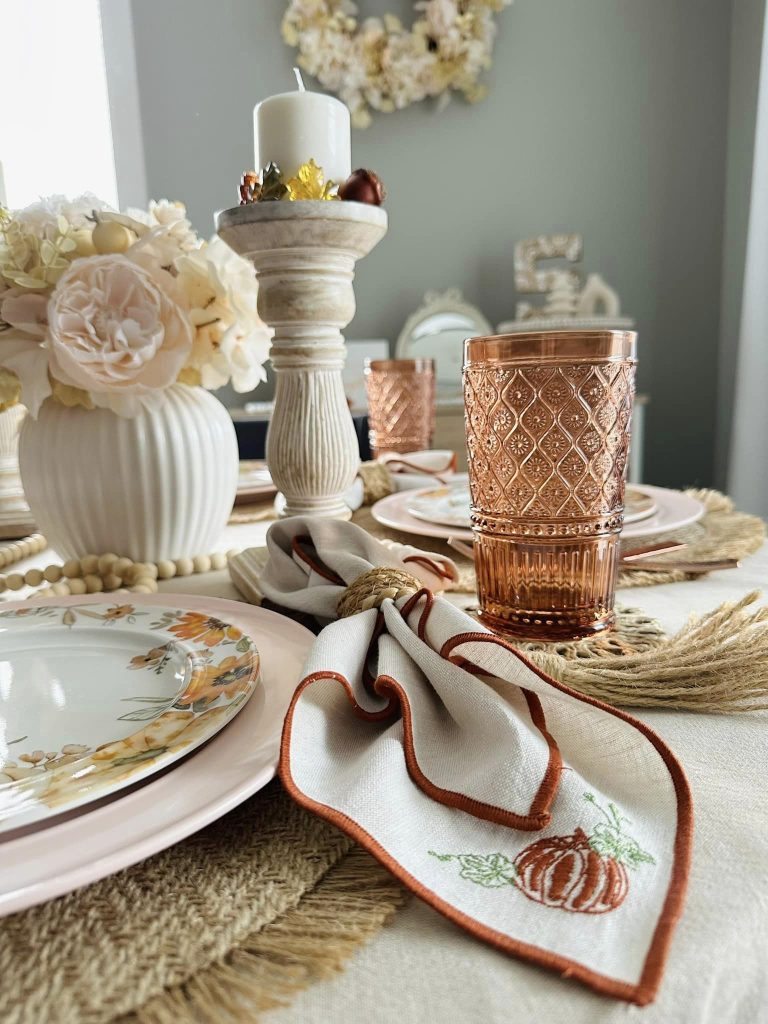
Easy and Quick Solutions
If time is limited, there are still plenty of options for centerpieces. Simple solutions include using store-bought items creatively. A large bowl of assorted fruits, like apples and pears, can act as a vibrant centerpiece.
You can also use a taper candle in a glass holder surrounded by pinecones or cranberries for a minimalistic approach. This creates a warm and inviting atmosphere without much effort.
Another quick idea is to gather mason jars filled with autumn leaves or acorns. Arrange them in a line down the center of the table for a charming effect. This can be done in just a few minutes, allowing you to focus on preparing the rest of your Thanksgiving meal.
Incorporating Natural Elements

Utilizing natural elements in your Thanksgiving centerpieces creates a warm, inviting atmosphere. By integrating seasonal harvest items and lush greenery, you enhance the aesthetics of your table setting while celebrating the essence of autumn.
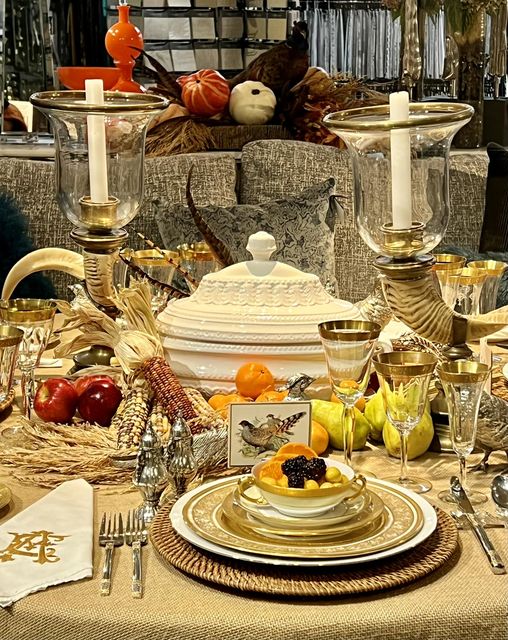
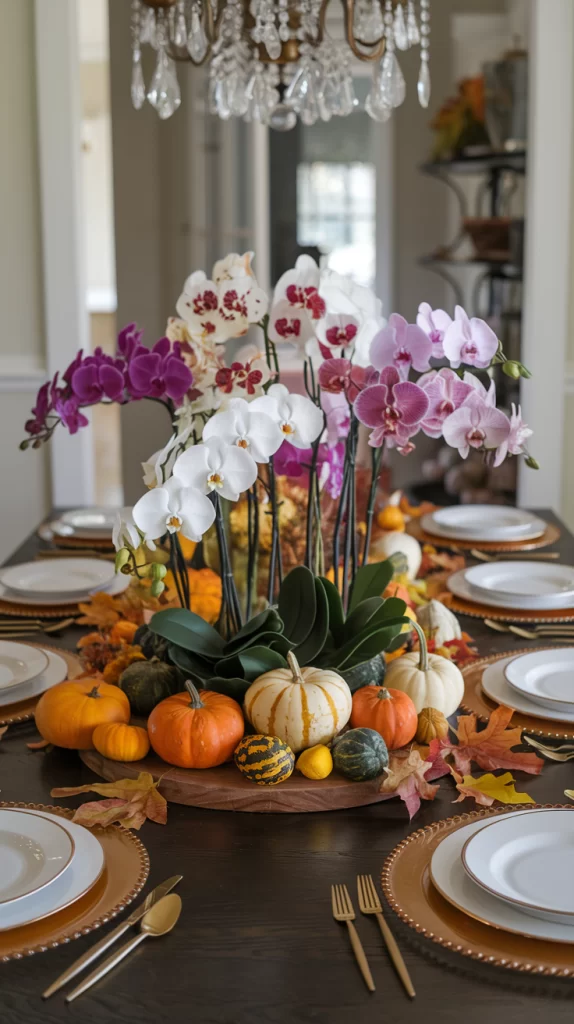
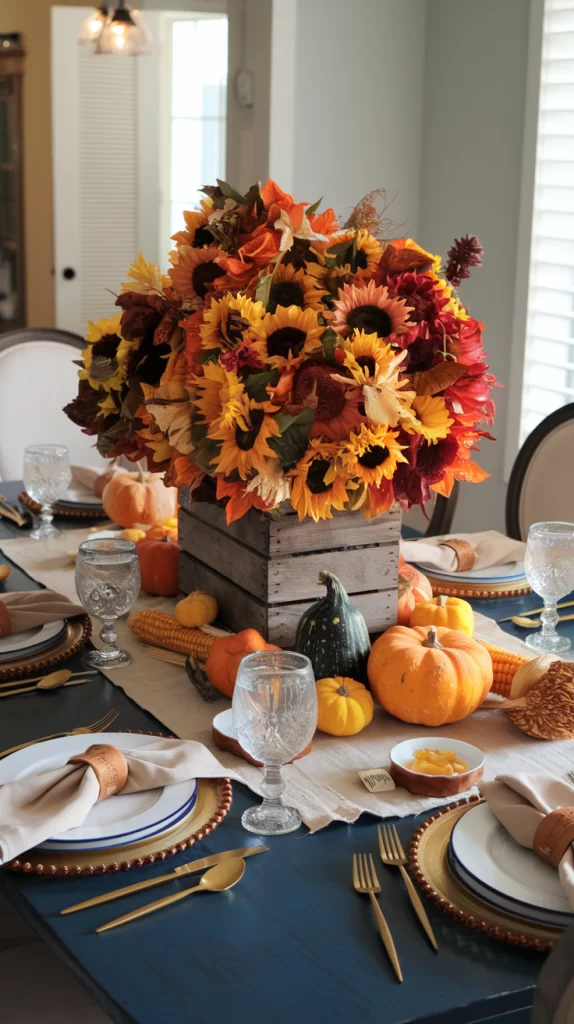
Using Seasonal Harvest
Include items like mini pumpkins, gourds, and apples in your centerpieces. These natural elements reflect the bounty of the season and are visually appealing. You might arrange them in rustic wooden bowls or tiered trays for added height.
Creating a Harvest Table Centerpiece can be as simple as placing a variety of fruits and vegetables in clusters. Consider using items such as cranberries or pears to introduce vibrant colors. Layering different textures adds depth, allowing the centerpiece to engage guests’ eyes throughout the meal.
You can also employ burlap or other natural fabrics as table runners, complementing the harvest theme. Mixing these elements creates a cohesive look that embodies Thanksgiving spirit beautifully.
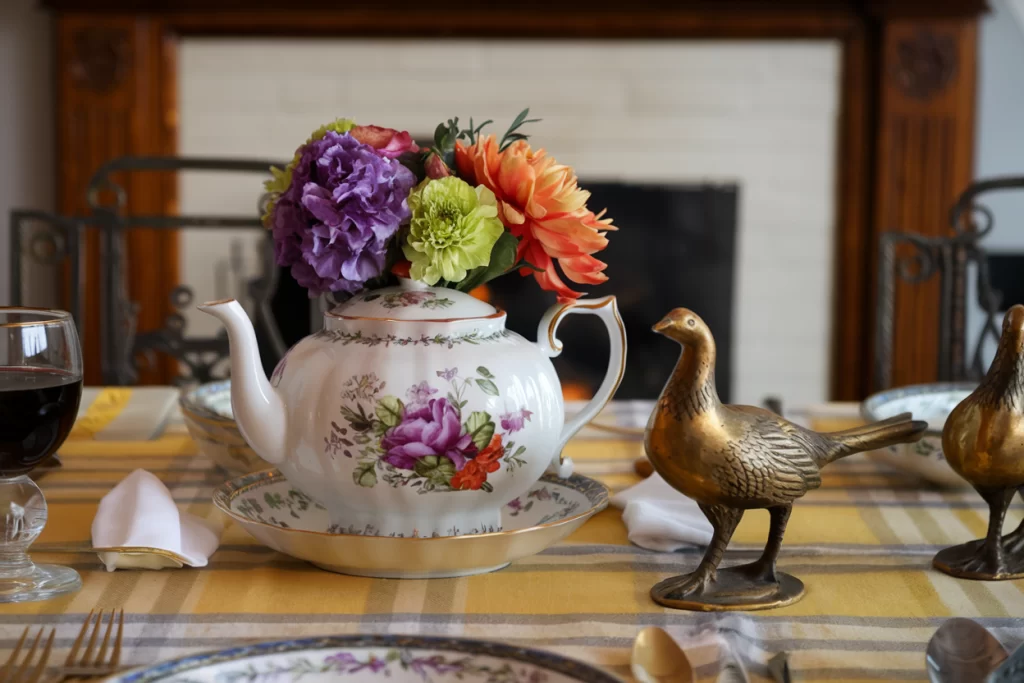
Adding Greenery and Flowers
Incorporating greenery and flowers elevates your arrangements. Use seasonal foliage like eucalyptus or maple leaves to frame your centerpiece. These elements provide a lush background and enhance the organic feel.
For Thanksgiving Flower Arrangements, select blooms in autumn hues—think deep reds, burnt oranges, and yellows. Mums, marigolds, and dahlias work well, creating vibrant bursts against the natural elements.
Pumpkin Floral Arrangements are a popular choice, where you hollow out a pumpkin to use as a vase. Fill it with seasonal flowers that complement your chosen palette. This not only looks festive but also ties back to the harvest theme effectively.
By thoughtfully selecting both harvest items and floral elements, your Thanksgiving table will be both beautiful and evocative of nature’s bounty.
Finishing Touches and Detailing

Incorporating finishing touches can elevate your Thanksgiving centerpiece. Focus on the elements that enhance aesthetics and create a welcoming atmosphere during your gathering.
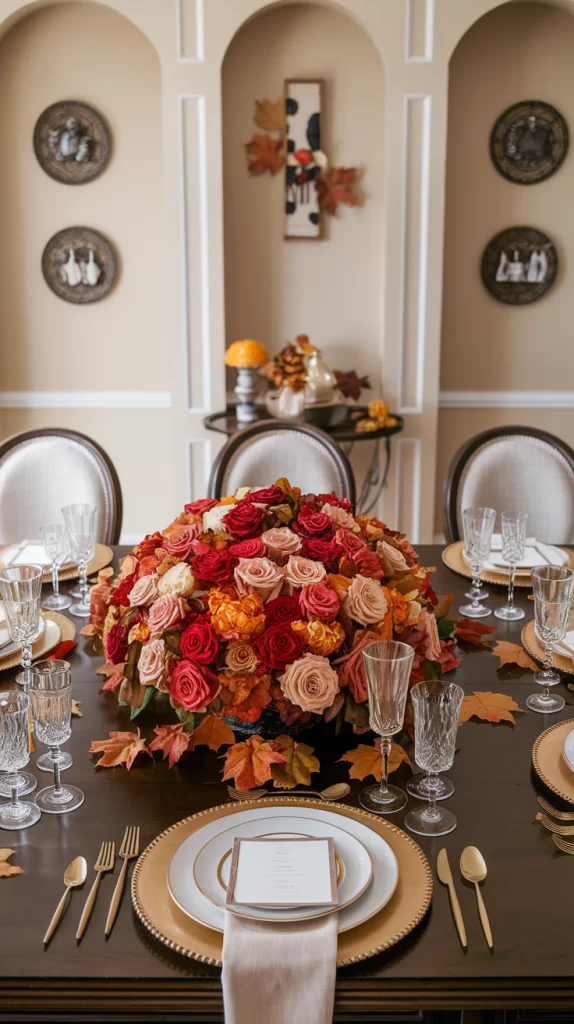
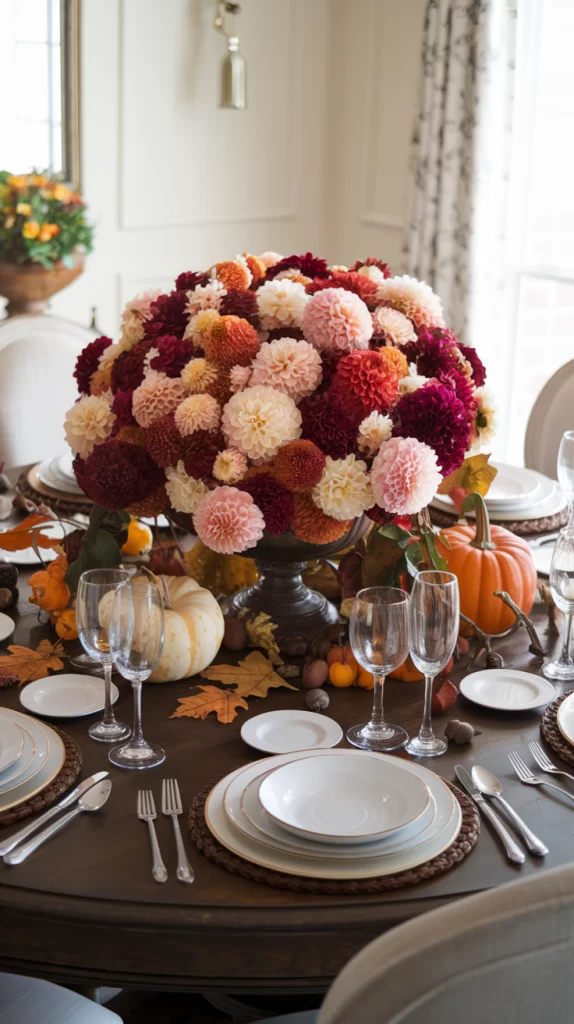
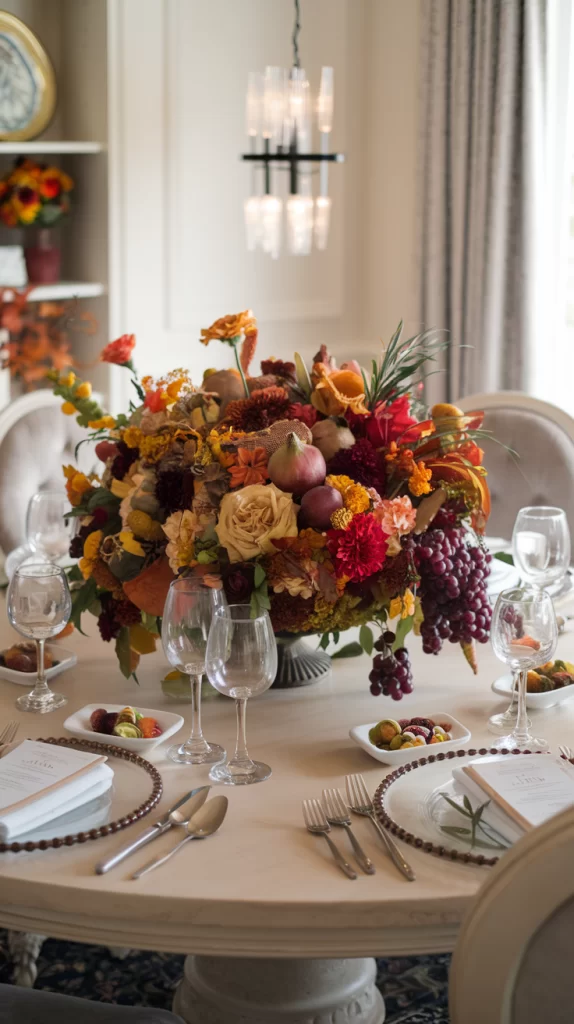
Accessorizing with Candles and Linens
Candles are a versatile addition to your Thanksgiving table. They can provide a warm, cozy ambiance. Consider using various heights and shapes for visual interest.
- Tea lights in small holders can be scattered throughout the centerpiece.
- Pillar candles can serve as focal points, surrounded by seasonal elements like pinecones or small pumpkins.
Selecting the right linens is equally important. A tablecloth or runner in autumnal colors can unify your theme. Consider using textured fabrics like linen or burlap for added depth.
Layering different cloths or using decorative napkins can enhance your Thanksgiving decorations table, complementing your centerpieces beautifully.
Personalizing Your Centerpiece
Personal touches can make your centerpiece feel unique and meaningful. Start with elements that reflect your personality or family traditions.
- Items like family heirlooms or handwritten name cards for each guest can add a personal touch.
- Consider using fresh produce, such as miniature gourds or seasonal fruits, to represent your region.
Incorporating DIY Thanksgiving tablescapes into your design can showcase creativity. You might create custom place settings with themes reflecting your favorite traditions. Ultimately, these personalized details help create a memorable atmosphere for your Thanksgiving gathering.
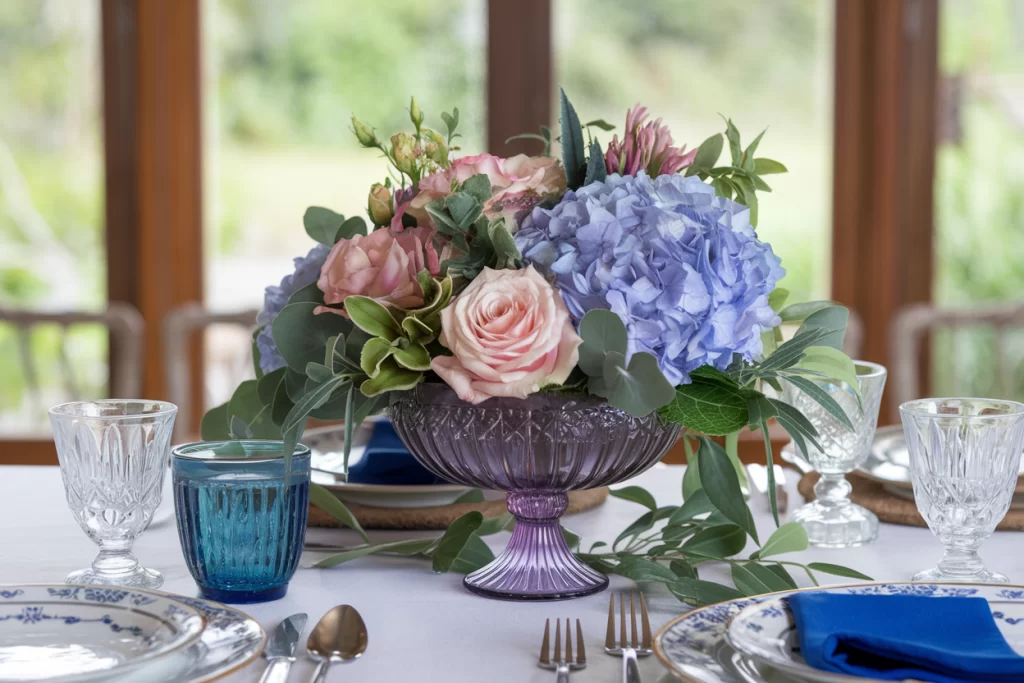
Thanksgiving Centerpiece Tips For A Warm And Welcoming Table
Thanksgiving brings everyone together around the table, and the centerpiece plays a big role in setting the mood. A well-planned design makes the meal feel more inviting without getting in the way of conversation or food. The best Thanksgiving centerpiece adds warmth, reflects the season, and keeps the table comfortable for everyone.
Think about balance when planning your display. Short arrangements allow people to see each other across the table, while natural elements like pumpkins, gourds, and greenery keep the look seasonal and simple. Small details, from floral accents to candlelight, give the table a welcoming atmosphere that feels thoughtful but not overwhelming.
With the right ideas, your centerpiece becomes more than decoration—it ties the whole table together. From fresh flowers to creative candle setups, there are plenty of ways to design something that feels festive and fits your style.
Essential Thanksgiving Centerpiece Tips
A Thanksgiving centerpiece should look inviting while still leaving room for food and conversation. The right design blends size, function, and style so your table feels festive without becoming crowded.
Choosing the Right Size and Height
Keep your centerpiece low enough so guests see each other across the table. A tall arrangement may look dramatic, but it blocks conversation. Aim for a height of 12 inches or less if it will sit in the middle of the table during the meal.
If you prefer some height, place taller items like branches or candles at the ends of the table. This keeps the center open and practical.
Consider the size of your table as well. A small table benefits from one compact arrangement, while a large table may need several smaller pieces spread evenly.
Balancing Function and Festivity
Your Thanksgiving centerpiece should add beauty without interfering with the meal. Avoid wide or bulky decorations that take up valuable serving space. A narrow runner with seasonal accents, such as pumpkins, gourds, or greenery, works well along the center.
Think about how the centerpiece interacts with food placement. Leave clear spots for platters and bowls so the arrangement feels integrated, not in the way.
Adding candles, fresh flowers, or autumn leaves brings warmth to the table while staying simple. Use unscented candles so they don’t compete with the smell of your Thanksgiving dishes.
Coordinating with Your Thanksgiving Table Setting
Match your centerpiece with the rest of your Thanksgiving table setting for a cohesive look. If your plates and linens have bold patterns, keep the centerpiece understated with solid colors and natural elements.
For a neutral table, add pops of color through flowers, berries, or small pumpkins. A mix of textures, such as wood, ceramic, and greenery, creates interest without overwhelming the setting.
Try repeating colors from your napkins or dinnerware in the centerpiece. This small detail ties everything together and makes the table feel planned. A well-coordinated centerpiece helps your Thanksgiving celebration feel polished and welcoming.
Incorporating Natural Elements
Natural pieces from the season bring warmth and character to your table. Pumpkins, gourds, pinecones, acorns, and fresh fruits create simple but eye-catching displays that feel connected to autumn.
Using Pumpkins and Gourds
Pumpkins and gourds work as a classic base for a Thanksgiving centerpiece. Mini pumpkins line up neatly down the center of a table, while a single white pumpkin makes a clean and modern focal point. Mixing sizes and colors adds variety without needing extra decoration.
For more interest, group pumpkins with small gourds in a basket, wooden tray, or low bowl. This keeps the display contained and easy to move if needed. Adding greenery such as eucalyptus or fresh herbs softens the look and fills in gaps between the pumpkins.
A simple way to vary the display is by mixing smooth and bumpy gourds together. The difference in textures makes the arrangement look fuller. Pairing them with candles in glass jars creates a warm glow that highlights the natural shapes of the pumpkins.
Adding Pinecones and Acorns
Pinecones and acorns add earthy details that balance brighter items like pumpkins or fruit. Scatter them loosely along a runner, or place them in small clusters beside candles. Their natural brown tones work well with both rustic and modern table styles.
A wooden bowl filled with pinecones offers a quick centerpiece on its own. For more variety, mix acorns with moss or dried leaves in a shallow dish. This creates a layered look that feels seasonal without relying on store-bought decor.
If you want height, tuck pinecones into a clear vase with twigs or branches. This keeps the table from looking flat while still staying simple. Acorns also work well as filler around larger items like gourds or floral jars.
Showcasing Seasonal Fruits
Seasonal fruits bring color and freshness to a Thanksgiving centerpiece. Apples and pears are easy to find in the fall and look appealing when grouped in bowls or scattered along the table. Their natural shine adds brightness without needing polish or extra work.
Try mixing red apples with green pears for contrast. Adding grapes or figs in small clusters makes the display feel abundant. Place the fruit on a wooden board or tray to keep the arrangement organized and easy to serve if desired.
For a more decorative style, combine fruit with greenery or herbs. A row of apples paired with sprigs of rosemary or thyme looks festive and smells inviting. Seasonal fruits also pair well with pumpkins, creating a balanced mix of colors and shapes that ties the centerpiece together.
Floral Arrangements for Thanksgiving
Seasonal flowers bring color and warmth to your table while dried elements add texture and depth. Mixing shapes, sizes, and tones creates balance and helps your centerpiece feel connected to the season.
Selecting Fall Flowers
Choose flowers that reflect autumn colors such as deep oranges, rich reds, and golden yellows. Popular picks include mums, dahlias, roses, goldenrod, and sunflowers. These blooms hold up well and naturally highlight the harvest season.
Think about the scale of your arrangement. Large blooms like dahlias or sunflowers create a bold look, while smaller flowers such as goldenrod or spray mums help fill gaps. Using a mix of both prevents the display from looking flat.
Keep in mind the vase or container. A low, wide bowl works well for dining tables since it doesn’t block conversation. Taller vases suit entryways or sideboards where height adds drama without being in the way.
Combining Fresh and Dried Flowers
Blending fresh and dried flowers adds variety and helps arrangements last longer. Fresh blooms bring vibrant color, while dried stems like wheat, eucalyptus, or preserved grasses add structure and contrast.
Use dried elements sparingly to avoid overwhelming the fresh flowers. For example:
- Fresh base: mums, dahlias, or roses
- Dried accents: pampas grass, wheat stalks, or dried goldenrod
This mix works especially well for Thanksgiving since it echoes the harvest theme. Dried flowers also reduce the need for constant upkeep, making the centerpiece easier to maintain throughout the holiday week.
When arranging, place dried stems around the edges or in between larger flowers. This frames the fresh blooms and keeps the arrangement looking balanced.
Creating Eye-Catching Flower Arrangements
Think about shape, height, and spacing when arranging flowers. A good rule is to keep the centerpiece about one and a half times the height of the container. This creates proportion without blocking sightlines across the table.
Layer flowers by size. Start with greenery at the base, add medium blooms like mums or roses, then finish with larger focal flowers such as dahlias or sunflowers. This step-by-step build keeps the arrangement structured.
Add interest by mixing textures. Pair smooth rose petals with the spiky look of goldenrod or the soft feel of dried grasses. Using different textures makes the arrangement more inviting and visually balanced.
Creative Candle Centerpieces
Candles bring warmth and light to a Thanksgiving table while also adding style. The way you choose the candles and arrange them with seasonal items makes the biggest difference in how your centerpiece looks.
Choosing Candle Types and Holders
Pick candle types that fit the size of your table. Pillar candles work well for larger tables because they stand out, while tea lights and votives suit smaller spaces. For a long dining table, taper candles in holders create height without blocking conversation.
The holder matters just as much as the candle. Glass jars, lanterns, or ceramic dishes keep wax contained and add character. If you prefer a modern style, use sleek metal holders. For a rustic look, try wooden bases or mason jars.
Keep safety in mind. Place candles in holders that won’t tip easily, and avoid scents that may compete with food aromas. A simple arrangement of unscented white candles in matching holders often works best for a meal-focused gathering.
Layering Candles with Other Elements
Candles look more inviting when paired with seasonal items. Surround them with mini pumpkins, pinecones, or gourds for a fall harvest theme. A tray filled with candles and fresh greenery, such as eucalyptus or rosemary, creates a natural look without much effort.
Mixing heights makes the display more interesting. Place taller candles in the center and shorter ones around them. Add small accents like cranberries in clear glass bowls or acorns scattered on the table to tie the look together.
For a budget-friendly option, use everyday items. A row of mason jars with tea lights and a few sprigs of autumn leaves gives a festive feel without extra cost. Keep arrangements low enough so guests can see across the table easily.
Unique Thanksgiving Centerpiece Ideas
Seasonal produce, natural textures, and simple DIY projects help create centerpieces that feel personal and festive. Mixing traditional autumn elements with creative arrangements makes your table look warm and inviting without being complicated.
Pumpkin Centerpiece Inspiration
Pumpkins work well as the base for many Thanksgiving centerpiece ideas. A hollowed-out pumpkin filled with fresh flowers creates a natural vase that looks seasonal and practical. For a smaller table, mini pumpkins grouped together with candles add color without taking up too much space.
Consider mixing different pumpkin varieties. White pumpkins paired with orange gourds give contrast, while striped or speckled pumpkins add visual interest. Placing them on a wooden tray or cake stand keeps the arrangement neat and easy to move.
Adding greenery like eucalyptus or simple fall leaves softens the look. Pairing pumpkins with unscented candles provides warm light that doesn’t compete with the meal. This combination balances decoration with function, keeping your table festive yet uncluttered.
Rustic and Modern DIY Options
Rustic designs often use natural materials such as wood slices, pinecones, and dried wheat. A simple burlap runner under these items creates a cozy farmhouse feel. Mixing in lanterns or mason jars with tea lights adds gentle lighting that feels relaxed and welcoming.
For a modern style, think clean lines and minimal color palettes. A glass vase with a few bold stems, such as sunflowers or deep red dahlias, makes a strong statement. Metallic accents like gold candle holders or copper bowls introduce shine without overwhelming the table.
Combining rustic and modern elements also works well. Pair a sleek vase with a wooden base, or set polished candles among natural gourds. This balance keeps the centerpiece fresh while still reflecting the season.
Finishing Touches and Styling Advice
Small details make a centerpiece look complete. Paying attention to color choices and adding simple accents helps your table feel inviting without being overwhelming.
Sticking to a Color Palette
Choose a color scheme before arranging your centerpiece to create a balanced look. Warm autumn shades like burnt orange, deep red, and golden yellow pair well with natural greens. Neutrals such as cream, beige, and soft gray keep the table from feeling too busy.
Mixing too many bold colors can distract from the meal. Instead, limit yourself to two or three main shades and add lighter tones for contrast. For example, pair burgundy napkins with ivory candles and greenery for a calm but seasonal display.
Patterns also matter. A plaid runner in muted tones works well with plain dishware. Metallics like copper or brass add shine when used in candleholders or vases, but keep them subtle so they highlight rather than dominate.
A simple table of ideas:
| Base Color | Accent Color | Neutral Balance |
|---|---|---|
| Orange | Dark Green | Cream |
| Burgundy | Gold | Beige |
| Mustard | Brown | White |
Adding Edible and Decorative Accents
Mixing natural and edible items creates interest while keeping the centerpiece practical. Small pumpkins, pears, or apples bring seasonal charm and are easy to arrange in bowls or along a runner. Fresh herbs like rosemary or thyme add greenery and a light fragrance.
Berries such as cranberries or hypericum stems bring pops of red that stand out against greenery. Scatter them in shallow dishes or tuck sprigs into napkin rings for a coordinated look.
Candles provide warmth but should stay low so guests can see across the table. Use unscented varieties to avoid competing with food aromas. For extra detail, tie ribbon or twine around candleholders or jars to match your color palette.
Mixing textures—like wood, glass, and fabric—keeps the arrangement from feeling flat. A woven basket filled with fruit, greenery, and a few pinecones creates a layered look without requiring much effort.
